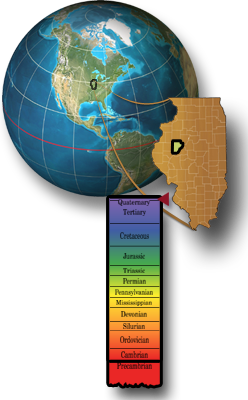
The Current Interglacial - A Warming Climate
Climate warming ended the most recent glacial advance, but the ice mass still took thousands of years to melt. By 12,000 years ago, the Midwest was ice-free. The shrinking glacier lay to the north in the Lake Superior basin and Canada. Earth’s climate was warming. Deciduous forests replaced the spruce and pine forests that could no longer survive in Illinois. Human populations were growing.
The period from 12,000 years ago to the present day is called the Holocene. It is a tiny slice of Earth’s history. On the Changes Institute time ribbon, where one inch represents one million years, the Holocene would be a line less than half the thickness of a credit card.
Why Do We Call This The Current Interglacial?
North America is still at high latitudes, and Earth's orbit and the tilt of its axis continue to change. Because of this, scientists think we are in a warm phase between glacial advances. They expect that glaciers will return. When? We're not sure—this is something we are studying at the Changes Institute.